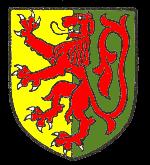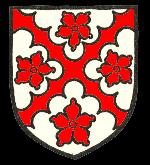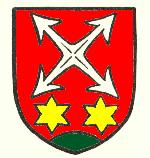Luton Manor
Luton possessed, at various times twenty six manors, large and small. The histories of all these manors are given in the Victoria County History for Bedfordshire, published in 1908 and due to be updated early in the 21st century.
After the Norman Conquest of England in 1066 the usurping King, William I, also called William the Bastard and William the Conqueror gradually set about taking away land from indigenous nobles (earls and thegns) and giving it to his own followers. Towards the end of his reign, winter of 1085, whilst at Gloucester, he ordered a complete survey of his kingdom to determine who held each piece of land. This survey became known as the Domesday Book and was carried out in just one year, 1086, a very impressive piece of logistical planning.
The book described Luton as a Royal Manor, held by the king himself. It contained 30 hides, had six mills (pairs of mill stones), enough woodland for 2,000 pigs and bought in a revenue from customary dues of 10 shillings 8 pence from tolls and 100 shillings from the market. The description went on: "In total, it pays £30 per year by weight and half a day's provisions in wheat, honey and other customary dues which belong to the King's revenue; to the Queen 4 ounces of gold; for a pack horse and other petty customary dues 70 shillings; for customary of dues, £6/10/-; from the increase which Ivo Tallboys put on £7 by weight and 40 shillings of white silver; 1 ounce of gold to the Sheriff [of Bedfordshire]".
The church was held by William the King's Chamberlain with five hides which belonged to it out of the manor's thirty. The church had a mill worth ten shillings and "the church pays 20 shillings a year", it had woodland for 50 pigs and had been held by a priest named Morcar during the reign of King Edward the Confessor (1042 to 1066). Together the Royal Manor and the church had 91 villagers, 51 smallholders and 3 slaves. Biscot manor had a further ten villagers and three slaves. These combined figures probably need to be multiplied by a factor of at least four - giving a population of between 650 and 700, a substantial number for Bedfordshire at that time (Leighton Buzzard had around 500, for example).
King Henry I (1100 to 1135) granted the manor to Earl Robert of Gloucester, his illegitimate son, who fought for Empress Maud, his half-sister in her civil war with King Stephen (1135 to 1154). He died in 1147 and was succeeded by his son William, who sold the manor to Earl Gilbert, who had his lands escheated to the crown for treason by King Stephen with the result that the Manor of Luton was given to Robert de Waudari. Subsequently Earl William, son of Earl Robert, had the manor restored to him and he died in 1182, the manor reverting to the crown. King Henry II (1154 to 1189) gave the manor to Baldwin de Béthune, later Earl of Albermarle. It passed to William Marshal, Earl of Pembroke, when he married Baldwin's daughter in 1214.

Marshal coat of arms
Marshal sided with the barons against King John (1199 to 1216) and lost the Manor of Luton to the crown, John giving it to his favourite Faulke de Breauté, who also held Bedford Castle and was High Sheriff of the county. After the fighting the manor was restored to Marshal who promptly gave it back to de Breauté! In 1220 de Breauté illegally seized houses belonging to a William de Stanes in Luton and the next year he built a castle in the town, which the prior of Dunstable felt was a threat to his priory. In 1224 de Breauté took pasture from thirty two free men in Luton for himself.
Luton Manor was granted back to William Marshal when he married Eleanor, sister of King Henry III (1216 to 1272) in 1229, three years after de Breauté's death in exile. Marshal died in 1231 and his widow married Simon de Monfort, Earl of Leicester, dying in 1274 when the manor passed to the heirs of Isabel de Clare. Her six daughters became their mother's co-heirs and on her death in 1275 the manor was duly divided between them; they were:
- Isabel, wife of Reginald de Mohun;
- Maud, wife of William de Kyme, later William de Vyvonia;
- Sybil, wife of Frank de Bohun;
- Joan, wife of John de Mohun;
- Agatha, wife of Hugh Mortimer of Chelmarsh;
- Eleanor, wife of William de Vaux, then Roger de Quincy, and finally Roger de Leyburne.
The Manor Divided
Isabel de Mohun's Portion
As well as her sixth of Luton Manor Isabel received quitrents of free tenants in Luton (i.e. their property was freehold and not copyhold) amounting to £5/19/- per annum. Isabel's estates passed to her son William who died in 1282 leaving a son, Reginald, who died without issue some time before 1297, his lands, then valued at £17/10/4 going to his sister Mary, wife of John de Meriet. Mary died without issue and, on her husband's death in 1327 the sixth share of the manor passed to other heirs of Isabel de Mohun - John de Beauchamp of Somerset, Henry, son of Roger, John de Bohun, John de Mohun and Hugh Mortimer. John de Bohun transferred his share to Hugh Mortimer in 1332 and likewise John de Beauchamp transferred his share to Mortimer in 1341. The shares of the other men cannot now be traced but may have eventually passed to the Mortimer or Wenlock families.
Maud de Kyme's Portion
Maud de Kyme died in 1299. She left four daughters as her co-heirs: Joan de Vyvonia, wife of Reginald Fitz Piers; Cicely, wife of John de Beauchamp of Somerset; Sybil, wife of Guy de Rochechouart; Mabel de Archiaco. Aymer, son of Mabel succeeded to her share. Sybil conveyed her share to Cicely in 1300. Aymer enfeoffed his share to Joan Fitz Piers and her son Reginald in 1308 - putting half Maud's share in the hands of Cicely and half in the hands of Joan. Joan died in 1314 and her son Reginald in 1328. His son, also Reginald, died in 1347. His son Edmund Fitz Herbert succeeded to a half share of Maud's fourth share of the manor and his son, also Edmund sold the share, then worth £8 per annum to William Wenlock in 1377. Cicely's half share in her mother's quarter of the manor was exchanged with Hugh Mortimer in 1318, she getting his estates at Sturminster Newton [Dorset] in return. Thus by the end of the 13th century half Maud's quarter was held by the Wenlock family and half by the Mortimer family, which also held some of Isabel's share as mentioned above as well as Agatha Mortimer's share.
Joan de Mohun's Portion
Joan was succeeded by her son John, who died in 1279, being succeeded by his ten year old son, also John. His grandson, another John enfeoffed his sixth of Luton Manor to Sir Nigel Loring of Chalgrave, one of the first Knights of the Garter, in 1375. His life was fictionalised by Sir Arthur Conan-Doyle in The White Company in 1891 and Sir Nigel in 1906. On Sir Nigel's death in 1386 a clerk, or churchman, named William Loring alienated his property to Dunstable Priory to fund daily masses for Sir Nigel's soul. The priory continued to hold the sixth share of Luton Manor until the dissolution and in 1545 Henry Audely and John Maynard received the priory's Luton lands. It is likely that the estate then passed to Sir Thomas Rotherham as Audely and Maynard seem to have acted as his trustees in other documents which survive from the time.
Sybil de Bohun's Portion
This portion of Luton Manor became known as Woodcroft alias Halyards Manor.
Eleanor de Leyburne's Portion
This portion of Luton Manor became known as Woodcroft Manor.

Wenlock coat of arms
Agatha Mortimer's Portion
Agatha died in 1306 and was succeeded by her son Henry and he, in turn, by his son Hugh. Hugh settled his share of the manor on his son Henry in 1344 and died in 1372, by which time Henry had also died and so Henry's son William inherited. In a deed of 1391 he was described as "a fool and an idiot" and, as a result of this mental handicap his lands were administered by the Crown. His brother Hugh eventually inherited his estates and died in 1403 without issue and his share of the manor passed to his cousin John de Cressy who died four years later, the manor eventually passing to his thirty three week old second son, also John, who lived until 1467 in which year he alienated his share in the manor to Lord John Wenlock, who changed sides twice during the Wars of the Roses and was killed for his second treachery during the Battle of Tewkesbury in 1471.
Wenlock's estates, which now included a full half of the Manor of Luton (the shares of Isabel de Mohun, Maud de Kyme and Agatha Mortimer) were forfeited to the Crown (then Edward IV) and were given to Thomas Rotherham, then Bishop of Lincoln and later Archbishop of York. The archbishop died in 1500 and his Luton estates passed to his brother John, who died in 1504 and was succeeded by his young son Thomas who died in 1565, probably after acquiring Joan de Mohun's sixth share of the Manor, bringing his ownership to two thirds of the medieval Manor of Luton. His Luton property went to his son George and, on his death in 1600, to his son Sir John Rotherham.

Napier coat of arms
In 1611 Sir John sold his half of the manor to Sir Robert Napier alias Sandy. He died in 1637 and passed to his son Robert Napier. He was an MP, first for Weymouth [Dorset] then Peterborough [Northamptonshire] and took the King's side during the First Civil War (1642 to 1646]. Parliament sequestered his estates in 1644 but was allowed to retain them in 1647. He died in 1660 having, in 1653, acquired both Woodcroft and Woodcroft alias Halyards Manor, the shares of the medieval Luton Manor of Sybil de Bohun and Eleanor de Leyburne. Thus he now owned the whole of the medieval manor, although both Woodcroft and Woodcroft alias Halyards retained their own separate identities.
The Manor Reunited in Ownership
Robert Napier was succeeded by his grandson, another Sir Robert, like his grandfather, who died without issue in 1675 leaving his uncle John as his heir. John Napier died in 1711 and was succeeded by his son Theophilus, who died without issue in 1719. His nephew John Napier succeeded and died in 1748, leaving the Luton estate to his aunt Frances, who devised it to her nephew Francis Herne who sold it to John Stuart, 3rd Earl of Bute in 1764. Bute was prime minister for just under a year from May 1762 to April 1763, having lost the confidence of King George III (1760 to 1820). He had the country house of Luton Hoo built by Robert Adam between 1767 and the 1770s. He was succeeded by his eldest son John, 1st Marquess of Bute on his death in 1792. The marquess died in 1814 and was succeeded by his grandson John Crichton Stuart as 2nd Marquess of Bute. The 2nd Marquess sold his Luton estate in 1844 to a man named Ward who sold it on in 1848 to John Shaw Leigh who died in 1871 and was succeeded by John Gerard Leigh, who on his death in 1878, was succeeded by his widow, later Madame de Falbe and, on her death in 1899, John Gerard Leigh's nephew succeeded, only to die within a fortnight leaving an infant son, whose trustees sold the manor, including Luton Hoo, to Sir Julius Wernher, a German born banker, in 1903. He died in 1912 and was succeeded by his son Sir Derrick Julius Wernher who died in 1948. However, a succession of Law of Property Acts in the 1920s effectively abolished manors in all but name. including copyhold land and manorial courts and income

Wernher coat of arms